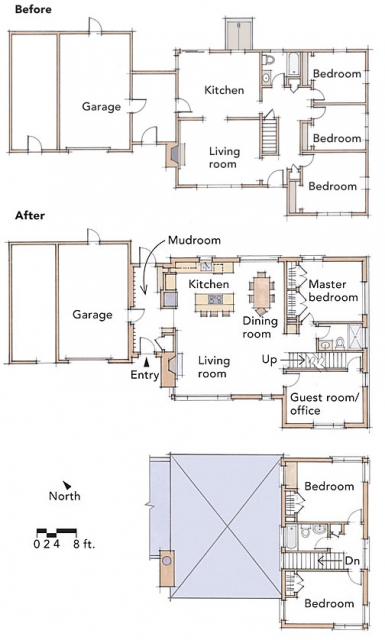
Image Credit: Charles Bickford
My wife, Betsy, and I searched for two years before we found the dump of our dreams: a tiny, dirt-cheap, and homely 1960s ranch that was within walking distance of our children’s school and was close enough to downtown Portland so that we could ride our bikes to work. Our hope was that we could renovate it into an affordable, stylish, and comfortable home. Our creative vision was strong enough to sense the glimmer of a diamond deep inside that forgotten home on Madeline Street.
The house was heavily distressed, its wiring was illegal and dangerous, and it was considered a menace by the neighbors. It leaked air to beat the band (15 ACH50/4000 cfm50), and the basement flooded every time it rained. The ceilings were a claustrophobic 7 ft. 6 in. high.
Why take this on? Residential architects usually want to build their own house at some point, so we figured, why not now? Plus, our kids were old enough to survive the remodel. As an architect, I thought the house would make a good low-energy-technique test case and a possible prototype for other office efforts at net-zero rehabs.
Don’t rush the renovation
We planned the design during our first year in the house, which allowed us to discover the many different aspects of the site. The existing house was just larger than 1100 sq. ft. I knew that expanding the footprint would expand the cost as well, so I followed the dictum of designing up, not out. I planned a compact two-bedroom second floor for the kids and enclosed the breezeway between the garage and the house. In total, I added 850 sq. ft.
GOING UP IS BETTER THAN GOING OUT
To save money, the new floor plan was kept to the original footprint. The author gained space by…
Weekly Newsletter
Get building science and energy efficiency advice, plus special offers, in your inbox.

This article is only available to GBA Prime Members
Sign up for a free trial and get instant access to this article as well as GBA’s complete library of premium articles and construction details.
Start Free TrialAlready a member? Log in
















2 Comments
Details...
I'm curious what you did for insulating/boxing around the old brick chimney.
Also the dense-packed scissor truss has only about R11 of exterior polyiso (assuming 2" of 2lb density roofing iso), for HOW much interior R? Seems like it would need an interior side vapor retarder to not run into moisture issues at the roof deck. In US climate zone 6 it takes about a 50/50 split between exterior-R and interior R to have any dew point margin at the roof deck.
Also, how was the thermal bridge at the top of the foundation dealt with- more 4" XPS on the band joist can-foamed in place?
Nice cove lighting in the living room!
Well Done
When can you come and do mine??? You did a really great job on your home....well done. We can't do our own, and in the tri state area, $200/ft (middle of the road materials etc) is considered a remarkable find......all this to say $90/ft is pure jealous tortue to think about :)
Log in or become a member to post a comment.
Sign up Log in